人教版八年级英语下册教案
- 格式:doc
- 大小:229.50 KB
- 文档页数:107
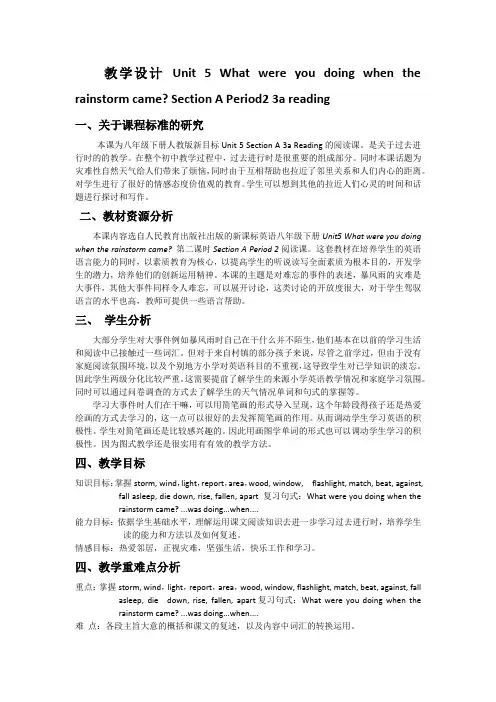
教学设计Unit 5 What were you doing when the rainstorm came? Section A Period2 3a reading一、关于课程标准的研究本课为八年级下册人教版新目标Unit 5 Section A 3a Reading的阅读课。
是关于过去进行时的的教学。
在整个初中教学过程中,过去进行时是很重要的组成部分。
同时本课话题为灾难性自然天气给人们带来了烦恼,同时由于互相帮助也拉近了邻里关系和人们内心的距离。
对学生进行了很好的情感态度价值观的教育。
学生可以想到其他的拉近人们心灵的时间和话题进行探讨和写作。
二、教材资源分析本课内容选自人民教育出版社出版的新课标英语八年级下册Unit5 What were you doing when the rainstorm came?第二课时Section A Period 2阅读课。
这套教材在培养学生的英语语言能力的同时,以素质教育为核心,以提高学生的听说读写全面素质为根本目的,开发学生的潜力,培养他们的创新运用精神。
本课的主题是对难忘的事件的表述,暴风雨的灾难是大事件,其他大事件同样令人难忘,可以展开讨论,这类讨论的开放度很大,对于学生驾驭语言的水平也高,教师可提供一些语言帮助。
三、学生分析大部分学生对大事件例如暴风雨时自己在干什么并不陌生,他们基本在以前的学习生活和阅读中已接触过一些词汇。
但对于来自村镇的部分孩子来说,尽管之前学过,但由于没有家庭阅读氛围环境,以及个别地方小学对英语科目的不重视,这导致学生对已学知识的淡忘。
因此学生两级分化比较严重。
这需要提前了解学生的来源小学英语教学情况和家庭学习氛围。
同时可以通过问卷调查的方式去了解学生的天气情况单词和句式的掌握等。
学习大事件时人们在干嘛,可以用简笔画的形式导入呈现,这个年龄段得孩子还是热爱绘画的方式去学习的,这一点可以很好的去发挥简笔画的作用。
从而调动学生学习英语的积极性。
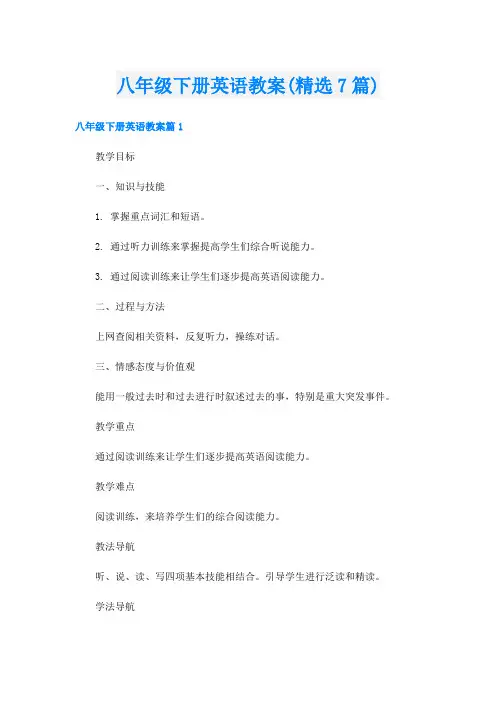
八年级下册英语教案(精选7篇)八年级下册英语教案篇1教学目标一、知识与技能1. 掌握重点词汇和短语。
2. 通过听力训练来掌握提高学生们综合听说能力。
3. 通过阅读训练来让学生们逐步提高英语阅读能力。
二、过程与方法上网查阅相关资料,反复听力,操练对话。
三、情感态度与价值观能用一般过去时和过去进行时叙述过去的事,特别是重大突发事件。
教学重点通过阅读训练来让学生们逐步提高英语阅读能力。
教学难点阅读训练,来培养学生们的综合阅读能力。
教法导航听、说、读、写四项基本技能相结合。
引导学生进行泛读和精读。
学法导航通过多种形式的运用,培养各种能力。
教学准备图片,多媒体。
教学过程Step 1 GreetingsGreet the students as usual.Step 2 RevisionAsk some students to report their dialogues.Step 3 Presentation1a, Think of a time when you were late for or couldn’t go to an event. What was the event? What was the reason why you were late or couldn’t go? Tell your partner the story. Then ask some students to tell their stories.Step 4 ListeningWhat happened to the girl? Let’s listen.1b, Listen and write short answers to the questions.1. What event happened at the school yesterday?2. Who missed the event?3. Which team won at the event?Play the recording at least twice and give the students enough time to write down their answers. Then ask some students to report their answers.1c, Listen again. Number the events [1-6] in the order they happened.____ Kate saw a dog by the side of the road.____ Kate got to the bus stop.____ Kate called the Animal Helpline.1 Kate left the house.____ Kate waited for someone to walk by.____ Kate realized her bag was still at home.Ask some students to report their answers.Step 5 Speaking1d, Talk about why Kate missed the school basketball competition. Student A begins a sentence with while or when. Student B completes the sentence.A:When she got to the bus stop,Kate …B:When she got to the bus stop,Kate realized that her bag was still at home.A:While she was running back home,…B:While she was running back home,she saw a dog by the side of the road.Encourage the students to make up as many dialogues as possible.Step 6 Presentation2a, Look at the pictures and the title in the passage. What do you think the passage is about?Remind the students to talk about it in pairs. Then ask some students to report their answers.Step 7 Reading2b, Read the passage and answer the questions:1. What are the two events in the passage?2. When did they happen?Ask some students to report their answers.2c Read the passage again. Are the following statements true (T) or false (F),or is the information not given (NG)?___ 1. Everyone in America remembers who killed Dr. King.___ 2. Robert Allen was eating lunch when Dr. King was killed.___ 3. Robert’s parents were shocked to hear the news.___ 4. Kate Smith was watching a movie when a plane hit the World Trade Center.___ 5. Kate didn’t think her friend was telling the truth about the event.Ask some students to report their answers.2d Underline sentences from the passage with similar meanings to the ones below.1. Not everyone will remember who killed him,but they can remember what they were doing when they heard that he got killed.2. No one said anything for the rest of dinner.3. September 11,2001—— the date alone means something to most people in the US.4. I had trouble thinking clearly after that because I was very afraid.Ask the students to read the passage carefully and try to find out the answers.Step 8 Language points1.My parents did not talk after that,and we finished the rest of our dinner in silence.in silence 沉默,无声e.g. Many patients were waiting in silence. 许多病人在静静地等候着。
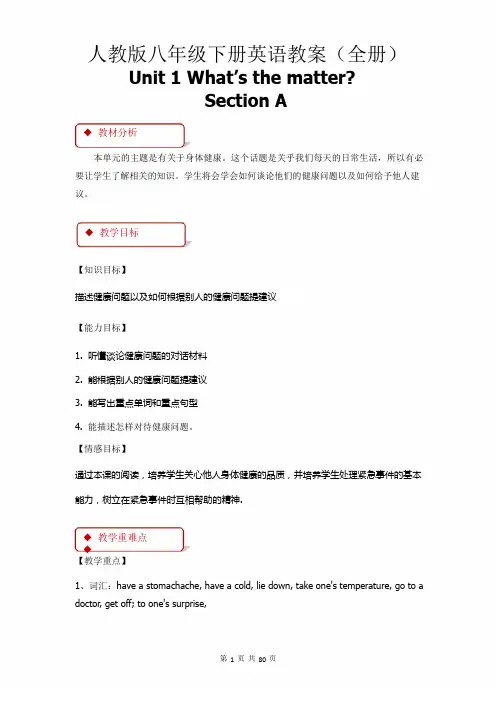
人教版八年级下册英语教案(全册)Unit1What’s the matter?Section A◆教材分析本单元的主题是有关于身体健康。
这个话题是关乎我们每天的日常生活,所以有必要让学生了解相关的知识。
学生将会学会如何谈论他们的健康问题以及如何给予他人建议。
◆教学目标【知识目标】描述健康问题以及如何根据别人的健康问题提建议【能力目标】1.听懂谈论健康问题的对话材料2.能根据别人的健康问题提建议3.能写出重点单词和重点句型4.能描述怎样对待健康问题。
【情感目标】通过本课的阅读,培养学生关心他人身体健康的品质,并培养学生处理紧急事件的基本能力,树立在紧急事件时互相帮助的精神.◆教学重难点◆【教学重点】1、词汇:have a stomachache,have a cold,lie down,take one's temperature,go to a doctor,get off;to one's surprise,2、句型:1.——What's the matter?——I have a stomachache.You shouldn't eat so much next time.2.——What's the matter with Ben?——He hurt himself.He has a sore back.——He should lie down and rest.【教学难点】掌握情态动词should shouldn't.的用法;学习have的用法◆课前准备◆Multimedia,group work,cooperative discussion.◆教学过程Step1.Warm up1.Look at the picture and learn the parts of the body.2.New words and phrases.Step2Presentation1.1aLook at the picture.Write the correct letter[a-m]for each part of the body.Then check the answers.2.1bFirst,lead Ss to read the five names.Then look at the picture.Number the names1-5.’sFinally, check the answers.3. 1cDivide two Ss into a pair to make conversations. Finally, invite several pairs to act outfor the class.Step 3 Practice1. 2aTell Ss there are five conversations. In each conversation the person says what goingon with them. Listen carefully and number the pictures.Play the tape. Then check the answers.2. 2bAsk Ss to listen to the recording again to match the problems with the advice.Play the recording again. Then check the answers.3. 2cAsk Ss to make conversations using the information in 2a and2b. Give them enoughtime to do this task. Later , invite several pairs to present their conversations to theclass.Step 4 Consolidation1. 2dFirst, ask Ss to have a fast reading of the conversation to get the main idea.Then, lead Ss to read the conversation sentence by sentence, explain some languagepoints.Finally, divide Ss into pairs to practice role-playing the conversation.2. 3aFirst, read the passage quickly and answer the question.Then,lead Ss to read the passage and analyse the key points.Finally,read together.3.3bRead the passage again and check the things that happened in the story3cDiscuss the questions with a partner.4.Grammar focusFirst,lead Ss to read the sentences.Then,prompt Ss to analyse the use of model verb should.After that,explain the grammar together.5.4aAsk Ss to fill in the blanks.Then,invite some Ss to present their answers.6.4bAsk Ss to circle the best advice for these health problems,then add their own advice.After that,invite some Ss to present their advice.7.4cOne student mimes a problem.The other students in your group guess the problem and give advice.Step5Language pointsStep6HomeworkMake a conversation about health problems and giving advice.Unit1What’s the matter?Section B◆教材分析本单元的主题是有关于身体健康。
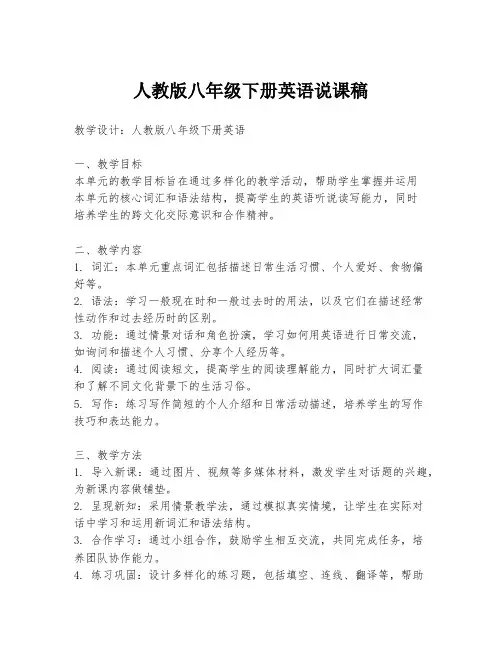
人教版八年级下册英语说课稿教学设计:人教版八年级下册英语一、教学目标本单元的教学目标旨在通过多样化的教学活动,帮助学生掌握并运用本单元的核心词汇和语法结构,提高学生的英语听说读写能力,同时培养学生的跨文化交际意识和合作精神。
二、教学内容1. 词汇:本单元重点词汇包括描述日常生活习惯、个人爱好、食物偏好等。
2. 语法:学习一般现在时和一般过去时的用法,以及它们在描述经常性动作和过去经历时的区别。
3. 功能:通过情景对话和角色扮演,学习如何用英语进行日常交流,如询问和描述个人习惯、分享个人经历等。
4. 阅读:通过阅读短文,提高学生的阅读理解能力,同时扩大词汇量和了解不同文化背景下的生活习俗。
5. 写作:练习写作简短的个人介绍和日常活动描述,培养学生的写作技巧和表达能力。
三、教学方法1. 导入新课:通过图片、视频等多媒体材料,激发学生对话题的兴趣,为新课内容做铺垫。
2. 呈现新知:采用情景教学法,通过模拟真实情境,让学生在实际对话中学习和运用新词汇和语法结构。
3. 合作学习:通过小组合作,鼓励学生相互交流,共同完成任务,培养团队协作能力。
4. 练习巩固:设计多样化的练习题,包括填空、连线、翻译等,帮助学生巩固所学知识。
5. 反馈评价:通过课堂小测验和作业检查,及时了解学生的学习情况,给予适当的反馈和指导。
四、教学过程1. 热身活动(5分钟)- 通过播放与日常生活相关的图片或视频,引导学生讨论自己的日常习惯和喜好。
2. 新课呈现(15分钟)- 教师介绍本单元的核心词汇和语法点,通过情景对话的方式,让学生在实际语境中学习和运用。
3. 合作探究(20分钟)- 分组活动,让学生通过角色扮演、信息差等方式,练习用英语交流和描述个人习惯和经历。
4. 练习巩固(15分钟)- 设计相关的练习题,让学生独立完成,然后小组内讨论答案,教师巡视指导。
5. 阅读拓展(10分钟)- 阅读一篇与单元主题相关的短文,让学生了解不同文化背景下的生活习俗,并回答相关问题。
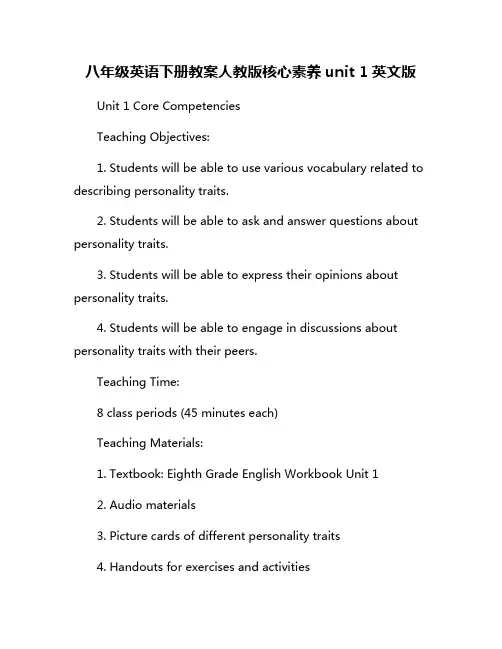
八年级英语下册教案人教版核心素养unit 1英文版Unit 1 Core CompetenciesTeaching Objectives:1. Students will be able to use various vocabulary related to describing personality traits.2. Students will be able to ask and answer questions about personality traits.3. Students will be able to express their opinions about personality traits.4. Students will be able to engage in discussions about personality traits with their peers.Teaching Time:8 class periods (45 minutes each)Teaching Materials:1. Textbook: Eighth Grade English Workbook Unit 12. Audio materials3. Picture cards of different personality traits4. Handouts for exercises and activitiesTeaching Procedures:Class 1:1. Warm-up: Play a game where students have to act out a personality trait without speaking and their classmates have to guess what it is.2. Introduce new vocabulary related to personality traits such as confident, outgoing, shy, funny, serious, etc.3. Practice pronunciation of the new vocabulary and have students repeat after you.4. Have students write short sentences using the new vocabulary.5. Homework: Review the new vocabulary at home and prepare to discuss personality traits in the next class.Class 2:1. Review the vocabulary from the previous class.2. Introduce question words such as "What's he/she like?" and "Is he/she...?"3. Engage students in pair work where they ask and answer questions about each other's personality traits.4. Discuss different personality traits in the class and have students express their opinions about them.5. Homework: Write a short paragraph describing their own personality traits.Class 3:1. Review the previous class's homework.2. Introduce adjectives to describe personality traits in more detail such as friendly, kind, energetic, etc.3. Practice using the new adjectives in sentences and short dialogues.4. Have students work in groups to create a skit where they act out different personality traits.5. Homework: Write a dialogue between two people discussing their personality traits.Class 4:1. Review the homework from the previous class.2. Listen to audio materials of different conversations about personality traits and have students answer questions based on them.3. Introduce expressions for giving opinions such as "In my opinion..." and "I think that..."4. Practice using the new expressions in discussions about personality traits.5. Homework: Prepare to present their skits in the next class.Class 5:1. Have students present their skits to the class.2. Discuss the different personality traits demonstrated in the skits and have students give feedback on each other's performances.3. Introduce vocabulary related to emotions such as happy, sad, angry, etc.4. Practice using the new vocabulary in sentences and short dialogues.5. Homework: Write a short paragraph describing how they feel about different situations.Class 6:1. Review the previous class's homework.2. Engage in a group discussion about different emotions and have students express their opinions on how to deal with them.3. Introduce expressions for expressing emotions such as "I feel..." and "It makes me feel..."4. Practice using the new expressions in discussions about emotions.5. Homework: Write a diary entry describing their emotions throughout the day.Class 7:1. Review the homework from the previous class.2. Listen to audio materials of different situations that evoke different emotions and have students answer questions based on them.3. Introduce expressions for asking for advice such as "What should I do?" and "Can you help me with...?"4. Practice using the new expressions in giving advice on how to deal with different emotions.5. Homework: Prepare to present their diary entries in the next class.Class 8:1. Have students present their diary entries to the class.2. Discuss the different emotions described in the entries and have students give feedback on each other's writing.3. Review all the vocabulary, expressions, and concepts learned in the unit.4. Engage in a group discussion about the importance of understanding and expressing personality traits and emotions.5. Homework: Write a reflection on what they have learned in this unit and how it has impacted their understanding of themselves and others.Assessment:1. Participation in class activities and discussions.2. Completion of homework assignments.3. Quiz on vocabulary, expressions, and concepts learned in the unit.4. Oral presentation of skits, dialogues, and diary entries.5. Reflection on learning outcomes.By following these teaching procedures and assessment methods, students will be able to improve their English language skills while also gaining a deeper understanding of themselves and others through discussions about personality traits and emotions. This unit will not only enhance their language proficiency but also contribute to their personal growth and interpersonal relationships.。
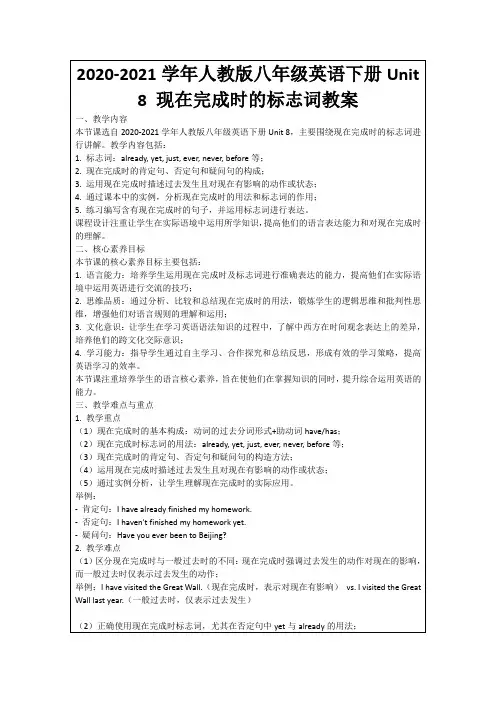
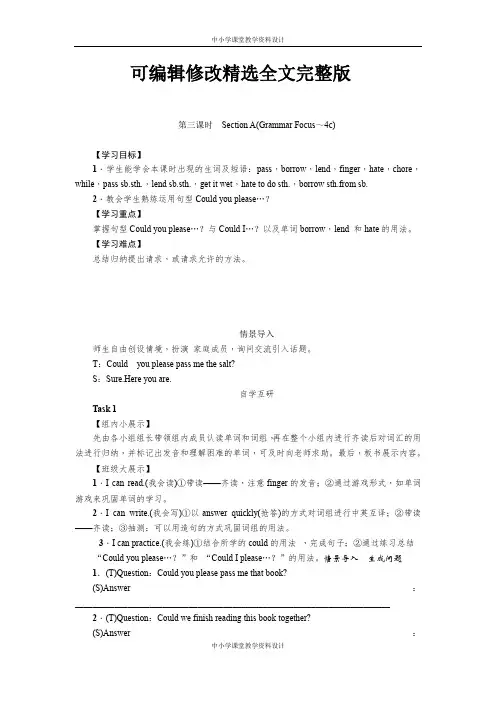
可编辑修改精选全文完整版第三课时Section A(Grammar Focus~4c)【学习目标】1.学生能学会本课时出现的生词及短语:pass,borrow,lend,finger,hate,chore,while,pass sb.sth.,lend sb.sth.,get it wet,hate to do sth.,borrow sth.from sb.2.教会学生熟练运用句型Could you please…?【学习重点】掌握句型Could you please…?与Could I…?以及单词borrow,lend 和hate的用法。
【学习难点】总结归纳提出请求,或请求允许的方法。
情景导入师生自由创设情境,扮演家庭成员,询问交流引入话题。
T:Could you please pass me the salt?S:Sure.Here you are.自学互研Task 1【组内小展示】先由各小组组长带领组内成员认读单词和词组,再在整个小组内进行齐读后对词汇的用法进行归纳,并标记出发音和理解困难的单词,可及时向老师求助。
最后,板书展示内容。
【班级大展示】1.I can read.(我会读)①带读——齐读,注意finger的发音;②通过游戏形式,如单词游戏来巩固单词的学习。
2.I can write.(我会写)①以answer quickly(抢答)的方式对词组进行中英互译;②带读——齐读;③抽测:可以用造句的方式巩固词组的用法。
3.I can practice.(我会练)①结合所学的could的用法,完成句子;②通过练习总结“Could you please…?”和“Could I please…?”的用法。
情景导入生成问题1.(T)Question:Could you please pass me that book?(S)Answer:________________________________________________________________________ 2.(T)Question:Could we finish reading this book together?(S)Answer:________________________________________________________________________自学互研生成能力Task 1Let's read the new words and phrases.1.I can read.(我会读)pass,borrow,lend,finger,hate,while,chore2.I can write.(我会写)(1)pass me the salt 递给我盐(2)come back too late 回来太晚(3)hate to do sth.讨厌做某事(4)finish reading 读完(5)hang out with my friends 与朋友闲逛(6)try(not)to do sth.尽量(不)做某事(7)get it wet 让它打湿(8)lend me some money借给我一些钱3.I can practice.(我会练)根据汉语意思完成下列句子,每空一词。
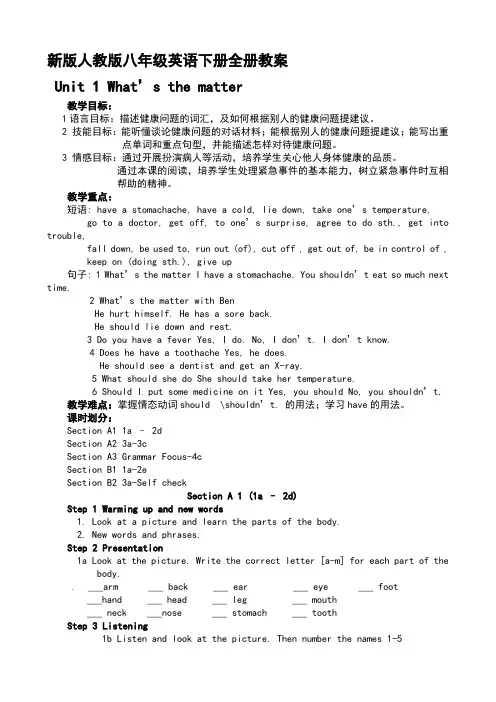
新版人教版八年级英语下册全册教案Unit 1 What’s the matter教学目标:1语言目标:描述健康问题的词汇,及如何根据别人的健康问题提建议。
2 技能目标:能听懂谈论健康问题的对话材料;能根据别人的健康问题提建议;能写出重点单词和重点句型,并能描述怎样对待健康问题。
3 情感目标:通过开展扮演病人等活动,培养学生关心他人身体健康的品质。
通过本课的阅读,培养学生处理紧急事件的基本能力,树立紧急事件时互相帮助的精神。
教学重点:短语: have a stoma chache, have a cold, lie down, take one’s temperature, go to a doctor, get off, to one’s surprise, agree to do sth., get into trouble,fall down, be used to, run out (of), cut off , get out of, be in control of , keep on (doing sth.), give up句子: 1 What’s the matter I have a stomachache. You shouldn’t eat so much next time.2 What’s the matter with BenHe hurt himself. He has a sore back.He should lie down and rest.3 Do you have a fever Yes, I do. No, I don’t. I don’t know.4 Does he have a toothache Yes, he does.He should see a dentist and get an X-ray.5 What should she do She should take her temperature.6 Should I put some medicine on it Yes, you should No, you shouldn’t.教学难点:掌握情态动词should \shouldn’t. 的用法;学习have的用法。
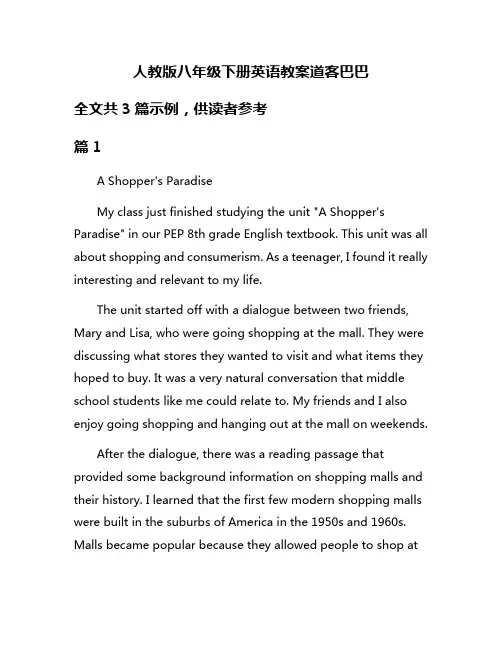
人教版八年级下册英语教案道客巴巴全文共3篇示例,供读者参考篇1A Shopper's ParadiseMy class just finished studying the unit "A Shopper's Paradise" in our PEP 8th grade English textbook. This unit was all about shopping and consumerism. As a teenager, I found it really interesting and relevant to my life.The unit started off with a dialogue between two friends, Mary and Lisa, who were going shopping at the mall. They were discussing what stores they wanted to visit and what items they hoped to buy. It was a very natural conversation that middle school students like me could relate to. My friends and I also enjoy going shopping and hanging out at the mall on weekends.After the dialogue, there was a reading passage that provided some background information on shopping malls and their history. I learned that the first few modern shopping malls were built in the suburbs of America in the 1950s and 1960s. Malls became popular because they allowed people to shop atmany different stores under one roof. They were protected from the weather and had amenities like food courts.As the reading passage described, malls offered a variety of shops selling clothes, shoes, accessories, electronics, sporting goods, books, toys, and more. Huge department stores often anchored the malls at either end. Walking through a big mall, you could find everything you needed all in one place. No wonder they were called "shoppers' paradises"!The passage also discussed some of the criticism around malls and excessive consumerism. It mentioned issues like traffic congestion, pollution from cars, destroying natural habitats to build malls, and encouraging people to spend beyond their means. However, it presented both sides in a balanced way.After reading and discussing the background information, we practiced various language skills related to shopping and spending money. This included lots of new vocabulary words like "bargain," "clearance," "splurge," "impulse buy," "window shopping," and more. We learned how to ask about prices, negotiating, and politely make requests at stores.There were also grammatical exercises on topics like forming plurals for different categories of merchandise. For example, we had to distinguish between singular and plural forms like "a pairof jeans" versus "two pairs of jeans." It was tricky but good practice.My favorite part was the role-play activities where we got to act out being shoppers and clerks at different types of stores. Getting into character and using the newly learnedwords/phrases made it much more engaging than just doing bookwork. I played the part of a sales associate at a clothing boutique trying to convince my friend to buy an overpriced handbag. It was fun!The unit culminated with a writing assignment where we had to describe our dream shopping mall and analyze the pros and cons of malls. I enjoyed flexing my creativity and argumentative skills for this essay. I designed my fantasy mall to have cool tech features like hologram assistants to help guide shoppers. But I also acknowledged some of the environmental downsides.Overall, I felt this was one of the most useful, practical units we've studied so far. As teenagers, my classmates and I are starting to shop independently and make decisions on how to spend our money. The skills we learned about budgeting, discounts, returns/exchanges, and responsible consumption will definitely come in handy. While it's fun to go on shoppingsplurges sometimes, this unit taught me the importance of being a smart, conscientious consumer.篇2The Guest is GodHave you ever heard the famous saying "The guest is God"? It's an Indian proverb that means you should treat your guests with the utmost respect and hospitality. This proverb is the central theme of the lesson "道客巴巴(The Guest is God)" in our 8th grade English textbook.The story is set in a small Indian village and follows a poor farmer named Sudama who used to be a childhood friend of Lord Krishna. Despite his humble circumstances, Sudama decides to visit the wealthy Lord Krishna who now lives in a grand palace. His wife is skeptical about the idea, questioning what kind of gift they could possibly bring that would be worthy of a king. But Sudama insists that the most valuable thing is the love and affection between old friends.With just a few handfuls of rice as a token gift, wrapped in an old cloth, Sudama sets off on the long journey to Krishna's palace. When he arrives, the guards initially turn him away, mocking his simple appearance. But Lord Krishna immediatelyrecognizes his childhood friend and rushes out to greet him with great joy and affection.Krishna embraces the poor Sudama warmly and ushers him inside with honor. Despite Sudama's embarrassment over his humble gift, Krishna accepts it as if it were the most precious offering. He treats his old friend as an honored guest, seating him comfortably and personally serving him delicious food and refreshments.As their reunion continues, Sudama starts to feelself-conscious about his poverty compared to Krishna's immense wealth and power as a king. But Krishna sees into his heart and reminds him that true friendship is beyond any materialistic concerns. Their bond is strong because it was formed in their innocent childhood days through sincere care and love for each other.In the end, when it is time for Sudama to depart, Krishna overwhelms him with abundant riches and treasures as a farewell gift. Sudama is reluctant to accept such valuable items, but Krishna insists, saying that he cherishes their friendship far more than any worldly riches. He asks only that Sudama returns home in peace and continues to regard him as a true friend for life.The story of the unshakable friendship between Lord Krishna and the humble Sudama drives home the moral of showing utmost respect, generosity and kindness to one's guests, no matter their social status. It teaches that the purest love stems from the depths of the human heart, not from materialistic considerations.From this lesson, I have learned the great significance of the Indian cultural value summed up in "The Guest is God." Even someone as powerful and wealthy as Lord Krishna honored his childhood friend Sudama and treated him as an esteemed guest deserving of the highest hospitality and warmth.The story has inspired me to be more welcoming, kind and generous towards any guests who may visit my home, regardless of their background or social standing. Like Krishna, I will aim to look beyond the surface and connect with the human essence of each guest through an open heart and sincere gestures of friendship.At the same time, I have also realized the reciprocal importance of being a gracious and humble guest myself when visiting others. Just as Sudama did not expect any grand reception despite Krishna's immense wealth, I too should not judge my hosts solely based on material factors. Instead, I shouldcherish the warmth of their hospitality and focus on upholding the human bonds of care and affection.The Indian ethos of "Atithi Devo Bhava" or "The Guest is God" is a profound philosophy that can help create a more compassionate and respectful world. By transcending superficial differences and nurturing the core human values of friendship, kindness and hospitality, we can strengthen the bonds that unite all people across all backgrounds and identities.In today's fast-paced world with its fair share of conflicts and divisions, this ancient wisdom of reverence for guests serves as a timeless reminder. It inspires us to slow down, disconnect from material pursuits, and reconnect with the inherent dignity and divinity within every human soul that arrives at our doorstep. I am grateful to have learned this lesson at a young age through our English textbook stories.篇3Dockaberra - An Imaginary World of WonderHey guys! Today I want to share my thoughts on the awesome lesson we just did in English class called "Dockaberra".I have to say, this was hands down one of the most fun andimaginative units we've covered so far this year. Let me tell you all about the wild and wacky world of Dockaberra!So Dockaberra is this make-believe place that our textbook describes. From what I understand, it's meant to be like a utopian society where everything is perfect and everyone is happy. The name "Dockaberra" itself is kind of a play on words combining "dock" (since it's an island) and "Canberra" which is the capital of Australia. Clever, right?The place is depicted as a remote island out in the middle of the ocean, untouched by the modern world. There are no factories or pollution, just pure natural beauty. The islanders live really simple lives as farmers and fishermen, growing their own crops and catching fish from the crystal blue waters. It's supposed to be like a paradise on Earth!One of the coolest things about Dockaberra is the way they make decisions. Instead of having one ruler or leader calling all the shots, they practice true democracy. Everyone has an equal say and they vote on every single decision that affects the community - how awesome is that? No parents, teachers or bosses telling you what to do, haha!From what the book describes, the islanders only work a few hours per day, with the rest of their time devoted to leisureactivities, sports, and cultural events. They have art festivals, music performances, athletic competitions - it sounds like an absolute blast. Sign me up to move there!Honestly though, my favorite part has to be their bizarre traditions and customs. For example, Dockaberra has this "Courtesy Custom" where you're supposed to mix up parts of common polite phrases. So instead of saying "Thank you very much" you'd say "Much thanks a lot". Or "Very nice to meet you" becomes "Meet you very nice". So weird but kind of hilarious!Then there's the whole concept of "Ramon Lists". Basically, the islanders make lists for every possible scenario or life event you can imagine. Need to pack for a trip? Consult the Ramon List on what to bring. Want to learn proper party etiquette? There's a Ramon List for that too. From the mundane to the extraordinary, they've got it all covered in list form!I could honestly go on and on about the quirky rituals and daily routines described in this lesson. The。
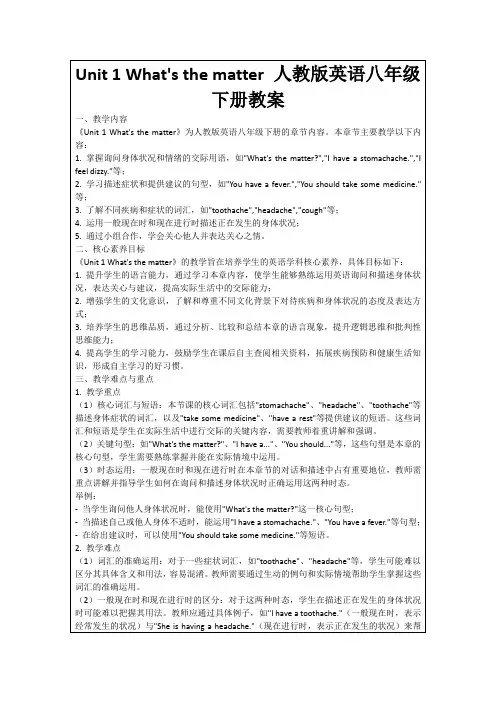
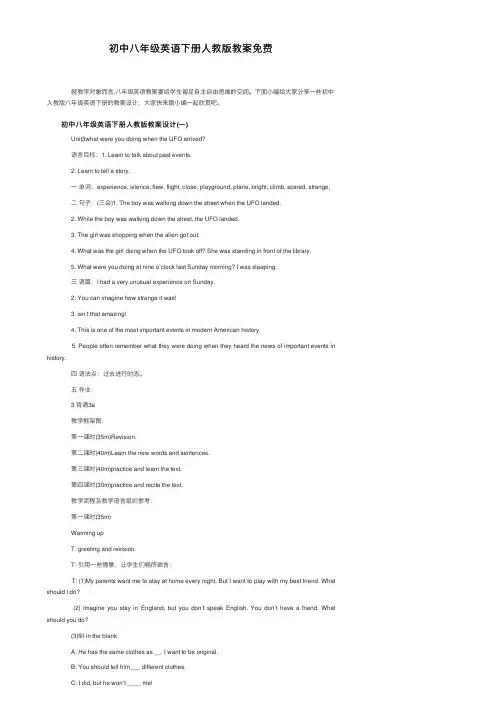
初中⼋年级英语下册⼈教版教案免费 就教学对象⽽⾔,⼋年级英语教案要给学⽣留⾜⾃主⾃由思维的空间。
下⾯⼩编给⼤家分享⼀些初中⼈教版⼋年级英语下册的教案设计,⼤家快来跟⼩编⼀起欣赏吧。
初中⼋年级英语下册⼈教版教案设计(⼀) Unit3what were you doing when the UFO arrived? 语⾔⽬标:1. Learn to talk about past events. 2. Learn to tell a story. ⼀单词:experience, silence; flew, flight, close, playground, plane, bright, climb, scared, strange, ⼆句⼦:(三会)1. The boy was walking down the street when the UFO landed. 2. While the boy was walking down the street, the UFO landed. 3. The girl was shopping when the alien got out. 4. What was the girl doing when the UFO took off? She was standing in front of the library. 5. What were you doing at nine o’clock last Sunday morning? I was sleeping. 三语篇:I had a very unusual experience on Sunday. 2. You can imagine how strange it was! 3. isn’t that amazing! 4. This is one of the most important events in modern American history. 5. People often remember what they were doing when they heard the news of important events in history. 四语法点:过去进⾏时态。
八年级下册英语人教版第六单元教案全文共3篇示例,供读者参考篇1Unit 6: I’m more outgoing than my sisterLesson 1: PersonalityObjectives:1. Students will be able to understand and use comparative and superlative adjectives to describe personality traits.2. Students will be able to discuss and compare their own personality traits with those of others.Language focus:Comparative and superlative adjectivesVocabulary related to personality traitsMaterials:Whiteboard, markers, handouts with personality traits vocabulary list, sample sentences for comparison practiceWarm-up (10 minutes):Begin the lesson by asking students to brainstorm as many adjectives as they can think of to describe personality traits. Write these adjectives on the board and discuss their meanings. Introduce the concept of comparative and superlative adjectives by explaining that they are used to compare two or more things. Provide examples using the adjectives already listed on the board.Presentation (15 minutes):Introduce the new vocabulary related to personality traits by giving students a handout with a list of words and their definitions. Have students practice pronouncing the words and understanding their meanings.Practice (20 minutes):Divide the class into pairs or small groups and give each group a set of cards with sentences using comparative and superlative adjectives. Students must match the sentences with the correct adjectives and discuss their meanings. Encourage students to form their own sentences using the adjectives in the cards.Production (15 minutes):Ask students to write a short paragraph comparing themselves with a family member or friend. They should use comparative and superlative adjectives to describe their personality traits. Encourage them to share their paragraphs with the class.Wrap-up (5 minutes):Review the key points of the lesson by asking students to give examples of comparative and superlative adjectives they used in their paragraphs. Assign homework that involves creating a poster with personality traits adjectives and their comparisons.Assessment:Monitor students during the production task to assess their understanding of comparative and superlative adjectives. Evaluate their participation in group discussions and their ability to use the vocabulary in context.篇2Unit 6: Could you please tell me where the restrooms are?Subject: EnglishGrade: 8thBackground Information:- This unit is focused on giving and asking for directions in English.- Students will learn vocabulary related to places in a city (e.g. bank, hotel, post office, etc.)- They will also practice using prepositions of place (e.g. next to, between, in front of, etc.)- In this unit, students will learn how to give and receive directions using imperative forms (e.g. turn left, go straight, take the second right, etc.)Objectives:- By the end of this unit, students will be able to give and ask for directions in English.- Students will be able to use prepositions of place correctly in sentences.- They will demonstrate understanding of vocabulary related to places in a city.Materials Needed:- Maps of cities for students to practice giving and asking for directions.- Flashcards with vocabulary related to places in a city.- Worksheets with exercises to practice prepositions of place and giving directions.Lesson Plan:1. Warm-up (10 minutes):- Start the lesson by reviewing vocabulary related to places in a city using flashcards.- Have students practice pronouncing the words and guessing the meaning of each word.- Play a memory game with the flashcards to help students remember the vocabulary.2. Introduction to prepositions of place (15 minutes):- Present the prepositions of place (e.g. next to, behind, in front of, etc.) using visual aids.- Give examples of sentences using prepositions of place and ask students to identify the preposition in each sentence.- Have students practice using prepositions of place in pairs by describing the location of objects in the classroom.3. Giving and asking for directions (20 minutes):- Introduce vocabulary related to giving and asking for directions (e.g. turn left, go straight, take the second right, etc.).- Model a conversation between two people asking for and giving directions using the vocabulary.- Have students practice giving and asking for directions in pairs using maps of cities.4. Applying the knowledge (20 minutes):- Divide the class into groups and give each group a worksheet with exercises to practice prepositions of place and giving directions.- Monitor and assist students as they complete the exercises.- Have each group present their answers to the class and provide feedback.5. Consolidation and assessment (10 minutes):- Review the key concepts of the lesson by asking students to summarize what they have learned about giving and asking for directions.- Assess students' understanding by asking them to write a short dialogue between two people asking for and giving directions.6. Homework assignment (5 minutes):- Assign homework that reinforces the lesson, such as writing a paragraph describing the location of objects in their bedroom using prepositions of place.Overall, this unit is designed to help students develop their speaking and listening skills in English while learning vocabulary and grammar related to giving and asking for directions. With a focus on interactive activities and practical exercises, students will have the opportunity to apply their knowledge in real-life situations.篇3Unit 6: Changing the worldPart 1: Teaching Aims1. To introduce students to new vocabulary related to changing the world.2. To help students understand the importance of making a positive impact on the world.3. To practice listening, speaking, reading, and writing skills related to the topic of changing the world.Part 2: Teaching Procedures1. Warm-up (10 minutes)Greet the students and introduce the topic of changing the world. Ask students to brainstorm ways in which they can make a positive impact on the world.2. Vocabulary (15 minutes)Introduce new vocabulary related to changing the world, such as "activist," "charity," "volunteer," "advocate," and "campaign." Have students practice using these words in sentences.3. Reading (20 minutes)Read a short passage about a famous activist or organization that has made a positive impact on the world. Askstudents comprehension questions to check their understanding.4. Listening (15 minutes)Play a recording of a speech given by a famous advocate for social change. Have students listen for key points and take notes.5. Speaking (20 minutes)Divide students into pairs or small groups and have them discuss ways in which they can make a positive impact on the world. Encourage them to share their ideas with the class.6. Writing (20 minutes)Assign students a short writing task in which they have to write a persuasive letter to a local organization or government official advocating for a change they would like to see in their community.7. Review (10 minutes)Review key vocabulary and concepts from the lesson. Have students share their writing assignments with the class.Part 3: HomeworkAssign students a research project in which they have to learn about a famous activist or organization that has made a positive impact on the world. They will present their findings to the class in the next lesson.Part 4: AssessmentAssess students' understanding of the topic of changing the world through their participation in class discussions, their completion of the writing assignment, and their presentation of their research projects.Overall, this unit aims to inspire students to think about the ways in which they can make a positive impact on the world and to encourage them to take action towards creating a better future for all.。
新人教版八年级下册初中英语全册教案(教学设计)一. 教学目标本教案旨在帮助八年级学生掌握下册初中英语的相关知识和技能,包括听、说、读、写四个方面的能力提高。
二. 教学内容本教案涵盖了全册的教学内容,包括以下单元和主要教学点:1. Unit 1: Meeting New Friends- 语言点:be动词的一般现在时- 活动:介绍新朋友- 阅读:了解文化差异2. Unit 2: The First Day at School- 语言点:一般过去时- 活动:描述第一天上学的经历- 阅读:理解校园规则3. Unit 3: I Love Reading- 语言点:情态动词can和must - 活动:介绍喜欢的书籍- 阅读:阅读理解4. Unit 4: My School Life- 语言点:形容词比较级和最高级- 活动:描述学校生活的不同方面- 阅读:了解不同的学校生活5. Unit 5: Our Future Jobs- 语言点:职业相关词汇- 活动:谈论未来的职业- 阅读:了解不同的职业6. Unit 6: Weather and Climate- 语言点:天气相关词汇和短语- 活动:讨论天气和气候- 阅读:了解不同地区的气候7. Unit 7: Enjoy Your Trip- 语言点:旅行相关词汇和短语- 活动:计划和描述旅行- 阅读:阅读旅行指南8. Unit 8: At the Farm- 语言点:动词的现在进行时- 活动:描述在农场的经历- 阅读:了解农场生活三. 教学方法本教案使用多种教学方法,包括但不限于:听力练、口语对话、阅读理解、小组讨论、写作练等。
教师将根据具体情况选择合适的教学方法进行教学。
四. 教学步骤1. 引入新课,激发学生兴趣。
2. 执行听力练以提高学生听力能力。
3. 进行口语对话练,帮助学生提高口语表达能力。
4. 进行阅读理解练,加深学生对课文的理解。
5. 进行小组讨论,让学生互相交流观点。
新人教版八年级英语下册第七单元第一课时-教案篇 1一、教学目标1. 知识目标(1)学生能够正确拼写和认读本课时的重点词汇,如“square”“meter”“deep”“desert”等。
(2)学生能够熟练掌握并运用重点句型,如“What's the highest mountain in the world?” “It's...” 等。
2. 能力目标(1)学生能够运用所学词汇和句型进行简单的交流,描述事物的特征和比较。
(2)提高学生的听说读写能力,培养学生的英语思维。
3. 情感目标(1)激发学生学习英语的兴趣,增强学习自信心。
(2)培养学生的合作意识和竞争意识。
二、教学重点与难点1. 教学重点(1)重点词汇的拼写、读音和用法。
(2)重点句型的结构和运用。
2. 教学难点(1)如何让学生在实际情境中灵活运用所学词汇和句型。
(2)帮助学生理解比较级和最高级的用法。
三、教学方法1. 讲授法教师通过讲解重点词汇和句型,让学生理解其含义和用法。
2. 游戏竞赛法组织单词接龙等游戏竞赛活动,激发学生的学习兴趣,强化词汇记忆。
3. 情景教学法创设真实的情景,让学生在情景中运用所学句型,提高语言运用能力。
四、教学过程1. 导入(5 分钟)(1)教师播放一段关于世界著名景点的英语视频,如埃菲尔铁塔、长城等,然后提问:“What can you see in the video?”引导学生用英语回答。
(2)教师接着说:“Today, we are going to learn something about the world. Let's start our journey!”2. 词汇学习(15 分钟)(1)教师展示本课时的重点词汇图片,如“square”(广场)、“meter”(米)、“deep”(深的)、“desert”(沙漠)等,一边展示一边领读,让学生跟读几遍。
(2)教师讲解词汇的词性、用法和例句,如:“square” 可以作名词,意为“广场”,“There is a big square in our city.”;也可以作形容词,意为“正方形的”,“The table is square.”(3)组织单词接龙游戏。
新人教版八年级英语下册《Unit 1》教案一. [话题](Topic)health二.[重点词组](Key Phrases)have a cold患感冒stressed out 紧张的,有压力的bean sprout豆芽get tired感觉疲惫stay healthy保持健康at the moment此刻,现在on the other hand另一方面get a cold患感冒see a dentist看牙医go to the party去参加聚会make sick使某人不舒服(患锁病)have a sore throat嗓子痛have a fever发烧,发热have a toothache牙痛have a backache背痛have a headache头痛三.[交际用语]1 关心别人:你怎么啦?What’s the matter?What’s the matter with you?What’s wrong?What’s wrong with you?2 关心别人:你是不是得……(病)了呀?Do you have a fever?Are you hungry?3 关心别人:你应该……,你最好……,为什么……?You should go to bed early.You shouldn’t eat anything for 24 hours.You’d better go to bed early.You’d better not eat anything for 24 hours.Why not go to bed early?Why don’t you go to bed early?4 关心自己:我不舒服,我病了,我饿了I’m not fe eling well.I have a headache.I am hungry.四. [重点难点释义](Language Points)1.What's the matter, Judy?朱迪,你哪里不舒服?(你怎么了?)matter n.问题,麻烦,事件,通常与介词“with”连用:What's the matter with him?他怎么了?这个句型可以与下面这两个句子互换:What's wrong with him?What's the trouble with him?wrong是形容词,前面没有“the”; matter和trouble都是名词,前面应有“the”, trouble前还可以用形容词性的物主代词。
人教版新目标英语八年级下册教案全册(共50份)Unit 3 Could you clean up your room?Section B (1a~1e)教学目标【知识与技能】1. 掌握本单元单词并正确使用以下常用表达法:buy some drinks and snacks, borrow some money, invite sb. to the party, make your bed…2. 能熟练掌握并使用下列重点句式:—Could you clean your room? —Yes, I can. —Could I invite my friends to a party? —No, you can’t have the party•Unit 3 Could you clean up your room?Section B (2a~3b)教学目标【知识与技能】1. 学习并掌握新词汇:chore; waste, provide, depend, drop等。
2. 能正确使用以下常用表达:a waste of time, provide sth. for sb., mind doing sth., take care of, depend on等。
3. 学会使用以下句型:they don’t have time… they should spend time on… it’s not enough to…, the+比较级,•Unit 3 Could you clean up your room?Section B (self check)教学目标【知识与技能】1. 学习并掌握新词汇:fair, unfair等。
2. 能正确使用以下常用表达:do chores; it’s fair/unfair for sb. to do sth.3. 注意正确搭配下列重点句式:do, clean, make, fold, sweep, take out4. 能熟练掌握并使用下列重点句式:I think/believe/agree that…; Can I/you…?【情感、态度与价值观】让学生学会征求他人的许可,并学会有礼貌地请•Unit 3 Could you please clean your room?Section A(1a~2d)教学目标【知识与技能】1. 掌握重点词汇rubbish,fold,sweep, floor, mess, take out the rubbish, fold the clothes, sweep the floor, all the time, make the bed, go out for dinner2. 掌握以下句型: 1.—Could you please sweep the floor? —Yes,sure.2.—Co•Unit 3 Could you please clean your room?Section A(3a~4c)教学目标【知识与技能】1. 学习掌握下列词汇:throw, neither, shirt, pass, borrow, lend, finger, hate, while, throw down, take the dog for a walk, be angry with, all the time, as soon as2. 句型:① For one week, she did not do any housework and neither did I.②—Could I b。
新人教版八年级下册英语教案一份优秀的英语教案是八年级英语教师上好一堂课的保障。
下面是小编为大家精心整理的新人教版八年级下册英语的教案,仅供参考。
新人教版八年级下册英语教案(一)Section B 1a-2e教学目标一、知识与技能1. 掌握新单词和短语。
2. 在不同的情境中正确、熟练地使用表示委婉请求的句型。
3. 培养听、说、读、写四项基本技能。
二、过程与方法观看,感受,模仿,实践。
三、情感态度与价值观认识到不仅在家庭中,在生活中的其他情况我们也要积极参加,勇于实践。
教学重点在不同的情境中正确、熟练地使用表示委婉请求的句型。
教学难点培养听、说、读、写四项基本技能。
教法导航创设情境,实践演练。
学法导航通过听说读写,独立思考,小组合作完成学习任务,提高各项能力。
教学准备图片,多媒体。
新人教版八年级下册英语教案(二)教学过程Step 1 GreetingsGreet the students as usual.Step 2 PreparationT:When I was a teenager,my parents often asked me to clean my room. Sometimes they asked me to buy some things. Now I often ask my daughter to take out the trash. What chores do your parents usually ask you to do?S1:My mother usually asks me to buy some food.S2:My mother often asks me to make my bed.S3:My father always asks me to clean my bike.S4:They ask me to clean my bedroom.T: Do you ask your parents to do anything? What do you ask them to do?S1:I ask my mother to make bed for me.S2:I ask my father to buy some books for me....Step 3 PracticeT:Look at the items in 1a,Section B. What can teenagers ask their parents to do? Whatdo parents ask their teenagers to do? Write “parents” or “teenagers” next to each phrase.Ask students to go through the phrases first. Give some explanations about the key words.teenager:someone who is between 13 and 19 years oldsnack:something eaten between mealsborrow:borrow sth from sblend:lend sth to sb/lend sb sthinvite:invite sb to sth (a wedding,party,meal,etc.) ; invite sb to do sthThen check their answers.Step 4 Pair workLet students use the phrases in activity 1a to make conversations between parents and teenagers. First,get a pair of students to read the sample conversations. Then students make their own conversations.Step 5 Listening1c, T:Now listen to the conversation between Sandy and her mom. Please check each item in activity 1a they talk about. Put a check mark in front of each phrase you hear.Play the recording,students only listen.Play the recording a second time. Students listen and check the items.Check the answers with the whole class.1d, T:From the conversation,we know Sandy will hold a party. She will invite some friends to the party. But she needs to do some preparation. She asks her mom to help her. And Dave is one of Sandy’s friends. He will also help Sandy do the preparation. So what is Sandy’s mom going to do? What is Sandy going to do? What are Sandy and Dave going to do? Let’s listen again and fill in the chart in activity 1b.Play the recording a third time. Ask students to write down the things the three people are going to do. Pause the tape where necessary. Then check the answers.Step 6 Pair work1e T:Suppose you are having a party. Make a list of things you need to do. Some things are already given. Write more things you need to do. Get students work in pairs and add more things to the list. For example:buy some CDs,decorate the walls,make some gifts ...T:Now make conversations and ask your partner to do some of the things for you. Then ask some pairs to demonstratetheir conversations.Step 7 DiscussionSay:Doing chores has advantages and disadvantages. What’s your opinion? Ask some students to report their opinion. Then say:Suppose you are Ms. Miller or Mr. Smith,after reading the two letters,work in groups and discuss the advantages and disadvantages of doing chores. After a few minutes,ask some groups to report their opinions.Step 8 ReadingSay:Read the letters again and try to find out the phrases in 2d. Ask some students totranslate the phrases first and then ask them to work in pairs to write one sentence with each phrase from the letters. Then ask some students to report their sentences.Step 9 Homework1. Finish the chart in 2c according to Ms. Miller and Mr. Smith.2. Discuss the questions in 2e with a partner.新人教版八年级下册英语教案(三)课堂作业I. Match the sentences( )1. Could I speak to Sam,please?( )2. Would you like to come to my birthday party tonight?( )3. May I come in?( )4. What about going out for a walk?( )5. Shall I open the door?( )6. Will you (please) lend your pen to me?a. Good idea!b. Yes,please.c. Certainly. Hold on,please.d. I’d love to.e. Sorry,I’m afraid not.f. Come in,please.II. Translate the sentences into English.1. 你能接一下电话吗?______________________________________2. 你能把书带到教室里去吗?______________________________________3. 你能帮我打扫房间吗?______________________________________4. 我能打开窗户吗?______________________________________5. 我可以借你的车吗?______________________________________参考答案:I. c d f a b e II. 1. Could you answer the phone? 2. Could you take the book to the classroom? 3. Could you help me clean the room? 4. Could I open the window? 5. Could I borrow your car?教学反思教师在开展教学活动时,个别小组出现“冷清”的场面,这些学生只顾自己独立思考,停留在独立学习的层次上,没有发挥合作学习的优势,使合作流于形式。
Unit 1 will people have robots ? Teaching goals:1. Words&phrases: robot, paper, less, fewer, simple, unpleasant,factory, seem, etc .2. will 构成的一般将来时态的陈述句、否定句、疑问句及回答.3. There be 句型的一般将来时.4. more , less , fewer 的用法.5. 学习一般将来时态的相关知识,学会对未来进行预测.6. 对five years ago ,today ,in five years 简洁回顾与展望的方式,贴近实际符合学生心理,激发学习兴趣.7. 通过时间对比复习一般过去时态、一般现在时态,巩固一般将来时.Important and difficult points :1. will 构成一般将来时态的句式。
2. There be 句型的一般将来时态。
3. more , fewer , less 的用法。
4. How to make predictions .Period 1Teaching procedures:Step 1 Leading in1. Greetings: Welcome to school .What’s the date today ? Who’s on duty today ?2Do you enjoy your winter holiday ?Do you finish your homework ?Do you want to live on the moon ?Can you guess what will happen in ten years ?Collect the Ss’ answers and say something about their predictions .Step 2 Pre-taskSB Page 2 ,1a .1. Look at the picture :How will the world be different in the future ,100 years from now ?We’re going to talk about sth in 100 years .2. Read each predictions to the class .Explain the new vocabulary .3. Read the instructions .Make sure Ss know what they should do .4. Do it by themselves .5. Talk about the answers with the class .Explain :一般将来时态构成: will / be going to +动词原形Step 3 While-taskSB Page 2 ,1b .1. Practise reading the six predictions .2. Read the instructions to Ss .Circle the things you hear on therecording .3. Play the tape twice .4. Play the tape a third time .At the same time ,check the answers .SB Page 2 , 1c .1. Pay attention to the dialogues .2. Read the dialogues fluently .3. Pairwork .Work in pairs to make predictions according to the sample .4. Ask several pairs to share their conversations to the class . SB Page 3 , 2a & 2b .1. Read the predictions .2. Read the instructions and point out the sample answer .3. Play the tape twice .Ss circle the word they hear in each sentences: more , less , fewer .4. Check the answers .学生探究: less , fewer 的区别。
Step 4 Post-task31. Point to the example in the sample dialogue .Practice reading .2. Look at activity 2b .Groupwork:Take turns to make conversations about the predictions .Grammar Focus:1. Review the grammar box .Ss say the statements and responses .2. Make summaries about “will” ,“fewer” and “less” . Homework:1. Make predictions about yourself in 10 years .Write down 5 sentences .2. Go over the new words .教学后记:Period 2Teaching procedures :Step 1 Leading in1. Greetings and free talk .2. Check their homework :Ask two or three Ss to speak out what they wrote down .(教师作出适当的评价)Step 2 Pre-task1. Go over what we learnt yesterday .2. 通过三种时间的对比简略复习一般过去时与一般现在时。
Step 3 While-taskSB Page 4 , 3a .1. Point to the three picture and say :This is Sally .The first pictureis Sally five years ago ,the second one is Sally now ,and the third one is Sally five years in the future .2. Read the instructions .3. Complete filling in the blanks individually .4. Check the answers .5. Practise reading .Then ask some Ss read them out .4SB Page 4 , 3b .1. Look at activity 3a .Make predictions about Sally .2. Point to the example in the sample dialogue .Ask two Ss to readthe dialogue to the class .3. Practise reading .4. Pairwork .Make their predictions about Sally .Step 4 Post-task1. Write about yourself .With the help of the sample of Sally .We can write sth about ourselves five years ago ,today and in five years .2. Complete the work individually .3. Review the task .Ask a few more Ss for answers . Homework :Draw a picture of the city in 20 years .Describe it to the class . 教学后记:Period 3Teaching procedures :Step 1 Leading in1. Greetings .2. Say yourselves :five years ago , today and in five years .3. Check the homework.Step 2 Pre-taskSB Page 5 , 1a .1. Look at the form and read the headings to the class .Make surethe Ss know what they mean .2. Read the list of seven words .Explain the new words .3. Write each word in the correct column .Check the answers. SB Page 5 , 1b .1. Read the words already written on the chart .2. Groupwork: Think about what we learned before .Write some 5words in the chart above .Divide the class into groups of four ,let them have a competition .Step 3 While-taskSB Page 5 , 2a .1. Look at the pictures carefully .Can you guess what we’ll listen ?Talk about them .2. Read the instructions .We’ll listen to 3conversations .Numberthe pictures 1-3 .3. Play the tape twice .Check the answers .SB Page 5 , 2b .This activity is easy ,I think .For we know the conversations aretalking about Alexis 10 years ago ,today and in 10 years .1. Read the instructions .2. Pay attention to the sentences and the verbs in the box .3. Play the tape and correct the answers .Step 4 Post-task1. Read the instructions .2. Pairwork. One is Alexis, one is Joe .3. Point out the example in the sample dialogue .Read it to the Ss .4. Talk about Joe’s life now , ten years ago and in ten years .5. Ask some pairs of Ss to say their dialogues . Homework:1. Go over the words .2. 写一篇50 个单词左右的小短文,预测与展望未来我们的学习和生活。